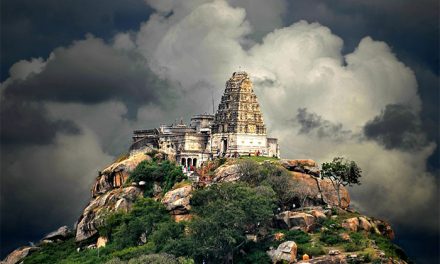The Srimad Bhagavataof Vyasadeva is accepted by the majority of scholars as a famous Mahapurana of India. This great Sanskrit work consists of eighteen thousand slokas and those are divided into twelve cantos (skandhas). The scholars opine that this work was first written in south India in the seventh century AD. Eventually, it spread extensively throughout India, mainly with the help of the Vaishnava sects under the guidance of different rulers. Over the succeeding centuries, hundreds of commentaries and annotations of this work were composed by the Indian pandits and poets not only in Sanskrit but also in various regional languages.
We are not sure about the time that the Bhagavata was first accorded the respect it now enjoys in North India or even how this development came about. However, we do know that in the middle of the eleventh century AD the Kashmiri poet Kshemendra wrote a poem on Sri Krishna, one of the incarnations (Avatara) of Lord Vishnu and that was ‘Dasavataracharita’.
In eastern India, the Bhagavata was translated into Bengali, Assamese and Oriya languages. In Assam, Srimanta Sankaradeva translated the first, second, eighth, tenth, eleventh and twelfth cantos of the Bhagavata into Assamese language in the fifteenth-sixteenth century, following the Sanskrit commentary of Sridhara Swami. He was a pioneer of this kind of work in Assamese literature. Jagannath Dasa, a famous Oriya poet and contemporary of Mahaprabhu Chaitanyadeva (sixteenth century AD) translated the twelve cantos of the Sanskrit Bhagavata in an easily intelligible form of Oriya language and was the first poet to do so in Oriya literature. His work was not only critically acclaimed, it was also popular amongst common people.
Bengali Bhagavatas
In Bengal, Maladhar Basu (Title: Gunaraja Khan) of Kulingram (currently in Burdwan District, West Bengal), wrote his Srikrishna Vijaya Kavya in Bengali, following the eleventh and twelfth cantos of the Bhagavata in 1480 AD. This Kavya is treated by the scholars as the first Bengali Bhagavata. The poet was inspired by Ruknuddin Burbak Shah, a Muslim ruler of the fifteenth century Bangal Subah or the Gourh. The ruler insisted that the Hindu poet translate the Hindu religious kavya in simple Bengali. Later on, a number of Bengali poets wrote kavyas on Radhakrishnalila of the Bhagavata. The majestic influence of Srichaitanyadeva and his preaching of a new kind of Bhakti cult inspired them to translate the Bhagavata into Bengali. Thus the medieval Bengali literature became enriched with the famous Bengali Bhagavata kavyas of Raghunath Pandit (sixteenth century), Dukshi Shyamdas (sixteenth century), Madhavacharya and others. These poets of the Vaishnava sect wrote their kavyas following the significant characters and events described in the original Bhagavata. So their kavyas were not the literal translation of the Bhagavata.
Sanatana’s Bhagavata Sanatana Vidyavagish Ghosal of the seventeenth century AD is the only Bengali poet of the medieval period who translated the complete Sanskrit Bhagavata of Vyasadeva consisting of twelve cantos. He used the well known metres payara and tripadi in the easy-to-understand Bangla language. While translating, he did not spare any sloka or part of the original work. Occasionally, he took the help of the Commentary by Sridhara Swami.
Sanatana has mentioned the year, month and date of writing different cantos by mysterious chronograms (Kavi Sakanka). Therefore, we may extrapolate that the poet translated the cantos of the Bhagavata in the following years:
Canto-I in 1679 AD
Canto-II in 1694 AD-1695 AD
Canto-III in 1694 AD
Canto-IV in 1696 AD
Canto-V in 1696 AD
Canto-VII in 1696 AD
Canto-IX in 1698 AD
But there is no mention of year and date in cantos VI, VII, X, XI and XII.
In the past, two copies of Sanatana’s Bhagavata were extant, one at Viswabharati (West Bengal) and another at Orissa Government Museum, Bhubaneswar. But in the copies preserved in these two collections, some of the cantos are incomplete. Thus the complete text of Sanatana’s Bhagavata was believed to be unavailable. However, recently the author of this article has discovered the complete text of tenth, eleventh and twelfth cantos of Sanatana’s Bengali Bhagavata written on tulat (country made paper). This discovery was made at a Vaishnava monastery at a village in the West Midnapur district of West Bengal.
It is beyond doubt that the twelfth canto was copied in the year 1741 Saka or 1819 AD. But the scribe Bangshibadan has forgotten to mention the year and date of copying the cantos ten and eleven. From the style of writing and other indicators it may be concluded that these were copied in the same year, and by the same scribe, Bangshibadan. In each concluding portion of the chapters or Bhanita, Sanatana has mentioned his work as Prakrita Bhagavata or Bhasabandha Bhagavata and he has identified himself as Sanatana Chakraborty, Bipra Sanatana, Sanatana Vidyabagish, et al. However, he has never made use of his ancestral title – Ghosal – although he belonged to the famous Ghosal family.
Concluding Remarks
This discovery is unique because until now it was believed that the complete text of Sanatana’s Bhagavata had been irrevocably lost. Now, if one were to take the first ten cantos from Viswabharati or Orissa State Museum and add these newly discovered cantos to them, a complete text of Sanatana’s Bhagavata may be published. If these manuscripts are published, readers may access the complete Bengali Bhagavata since Sanatana was the only poet to have translated Vyasa’s original Bhagavata in Bengali without abridging the text at all.











